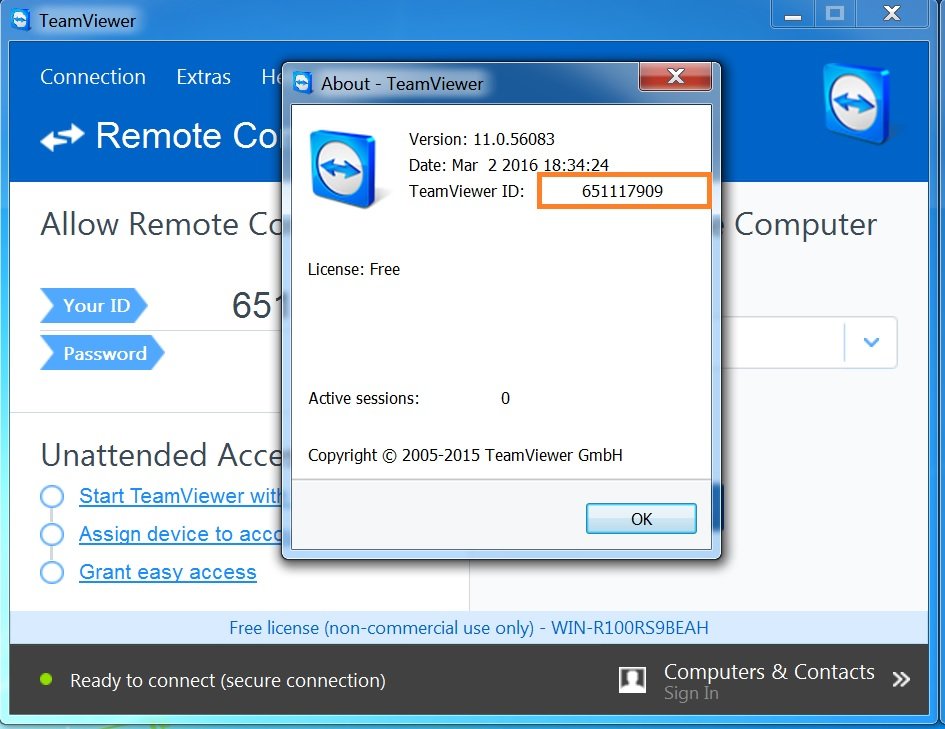TeamViewer for Windows
- Oct 08, 2012 Here is how to get a new TeamViewer ID on windows: 1. Remove your Teamviewer installation, and every folder named 'TeamViewer' in your profile folder. Remove your temporary files using avg tuneup by using erase privacy history, check on every option on it. Change your computer name, but do not reboot.
- Sounds great right? When TeamViewer sets up the TeamViewer ID, it makes it so that you cannot easily change it. Unfortunately, that means that on cloned Mac systems, the TeamViewer ID will be the same on the old and the new Macs, pretty much rendering TeamViewer useless when both cloned and original Macs are running.
- SPECIAL OFFER: Get Your 20% TeamViewer Discount Coupon Today! Find the right license that fits your needs. Check out our available AddOns, such as support for mobile devices and grab the free discount offered for a short time.
If you simply drag the TeamViewer application file to your Trash, it will leave its configuration files behind on the computer. The correct way to uninstall TeamViewer running on Mac OS X or macOS is to use our built-in uninstall button from within the TeamViewer preferences, as explained below. It probably works like this. When you first start TeamViewer (with no configuration files available), it looks up your MAC address. If it is not known by TV, it creates a new TeamViewer ID and associates your MAC address with it. If the MAC address is known, you get the teamviewer ID associated with it.
- Establish incoming and outgoing connections between devices
- Real-time remote access and support
- Collaborate online, participate in meetings, and chat with others
- Start using TeamViewer for free immediately after downloading
Buy a license in order to use even more TeamViewer features
Check out additional TeamViewer remote desktop support and collaboration downloads
Immediate assistance:
TeamViewer QuickSupport
Optimized for instant remote desktop support, this small customer module does not require installation or administrator rights — simply download, double click, and give the provided ID and password to your supporter.
Join a meeting:
TeamViewer QuickJoin
Easily join meetings or presentations and collaborate online with this customer module. It requires no installation or administrator rights — just download, double click, and enter the session data given to you by your meeting organizer.
TeamViewer MSI package
TeamViewer MSI is an alternative installation package for the full version of TeamViewer or for TeamViewer Host. TeamViewer MSI is used to deploy TeamViewer via Group Policy (GPO) in an Active Directory domain.
To download, log in to your account in the Management Console; go to the Design & Deploy section; and create a custom host or edit your existing custom host. In the customization menu, you will have the option to download your MSI package.
Please note: TeamViewer MSI is only available with a Corporate license.
TeamViewer Portable
TeamViewer Portable generally comprises all the features of the full version of TeamViewer without the need to install anything. Instead, TeamViewer portable runs directly from a USB stick or a CD — TeamViewer Portable is the perfect solution when you are on the road and using different computers.
Unattended access:
TeamViewer Host
TeamViewer Host is used for 24/7 access to remote computers, which makes it an ideal solution for uses such as remote monitoring, server maintenance, or connecting to a PC or Mac in the office or at home. Install TeamViewer Host on an unlimited number of computers and devices. As a licensed user, you have access to them all!
Previous versions:
These downloads are only recommended for users with older licenses that may not be used with the latest release of TeamViewer.
See previous versions
Supported operating systems
TeamViewer for Mac
- Establish incoming and outgoing connections between devices
- Real-time remote access and support
- Collaborate online, participate in meetings, and chat with others
- Start using TeamViewer for free immediately after downloading
Buy a license in order to use even more TeamViewer features
Check out additional TeamViewer remote desktop support and collaboration downloads
Immediate assistance:

TeamViewer QuickSupport
Optimized for instant remote desktop support, this small customer module does not require installation or administrator rights — simply download, double click, and give the provided ID and password to your supporter.
Join a meeting:
TeamViewer QuickJoin
Easily join meetings or presentations and collaborate online with this customer module. It requires no installation or administrator rights — just download, double click, and enter the session data given to you by your meeting organizer.
Unattended access:
TeamViewer Host
TeamViewer Host is used for 24/7 access to remote computers, which makes it an ideal solution for uses such as remote monitoring, server maintenance, or connecting to a PC or Mac in the office or at home. Install TeamViewer Host on an unlimited number of computers and devices. As a licensed user, you have access to them all!
How to use djay 2 app. How do I reinstall an older version of djay for iOS (djay 2 or djay Pro)? Open the App Store app, then tap Today at the bottom of the screen. Tap or your photo in the upper-right corner, then tap Purchased. Jan 27, 2020 Introducing djay 2 - the next generation of the world's best-selling DJ app is now available on Android. Djay transforms your Android device into a full–featured DJ system. Seamlessly integrated with Spotify and all the music on your device, djay gives you direct access to mix your favorite songs and playlists instantly.
What Is My Teamviewer Id
Previous versions:
These downloads are only recommended for users with older licenses that may not be used with the latest release of TeamViewer.
What Is A Teamviewer Id
See previous versions
Supported operating systems